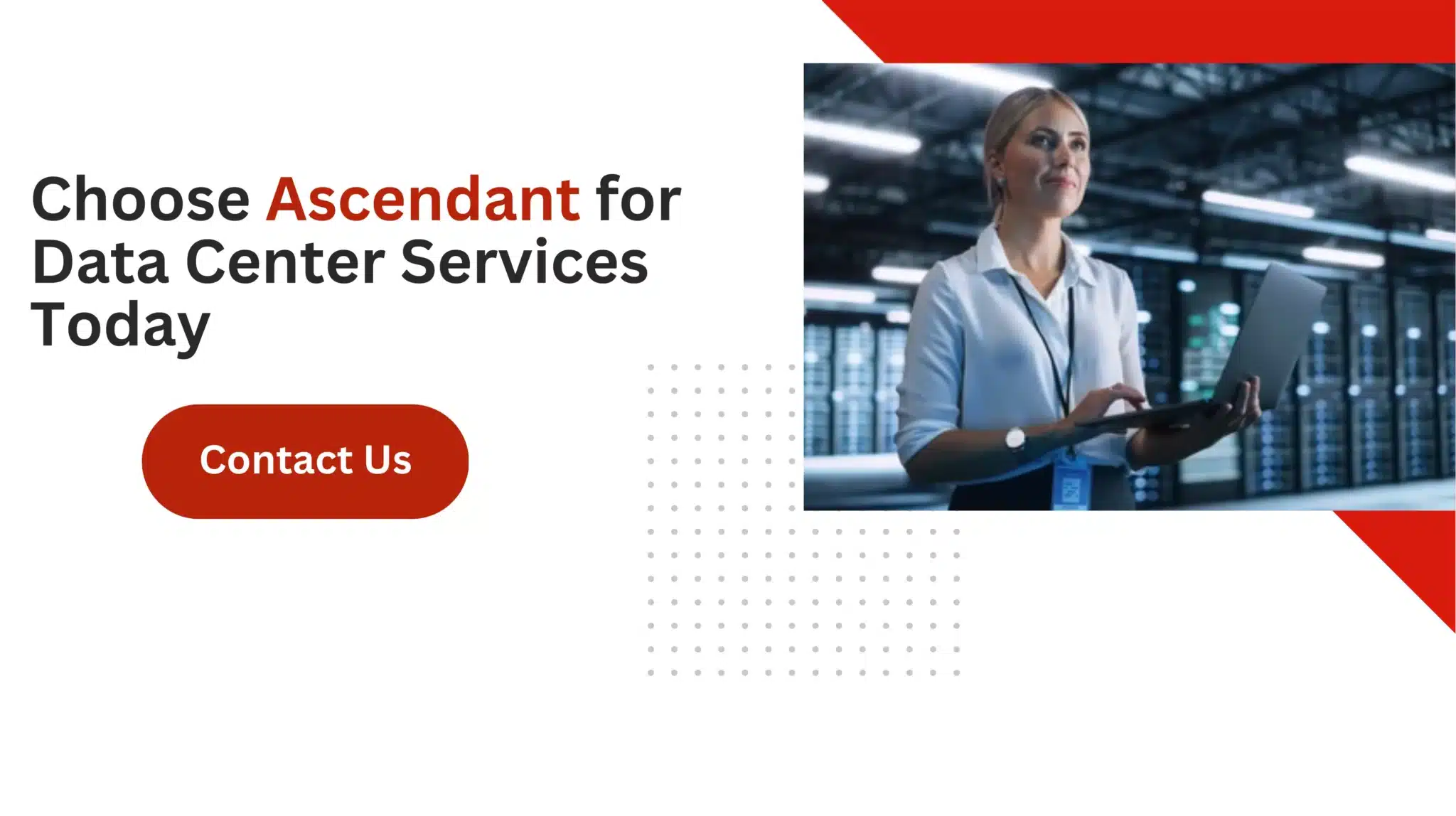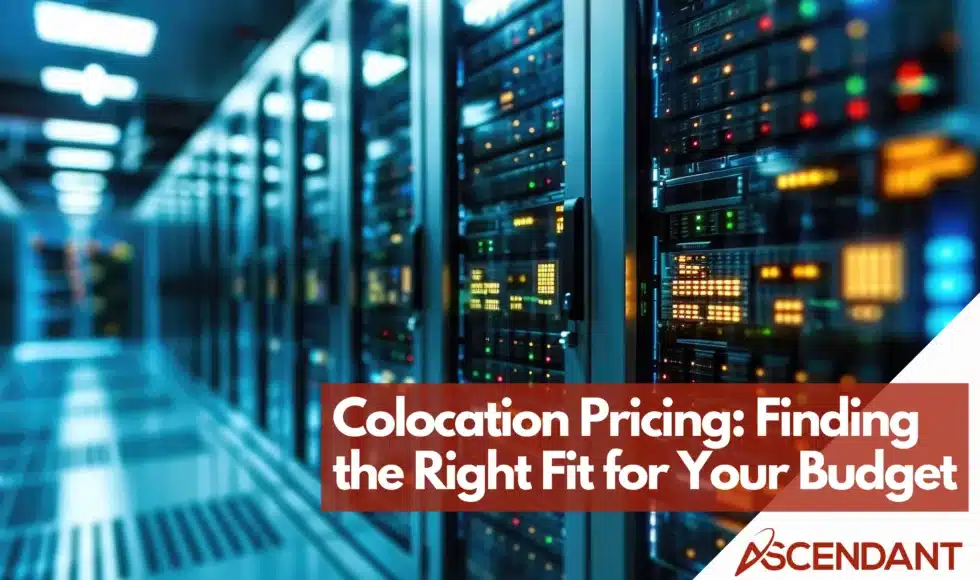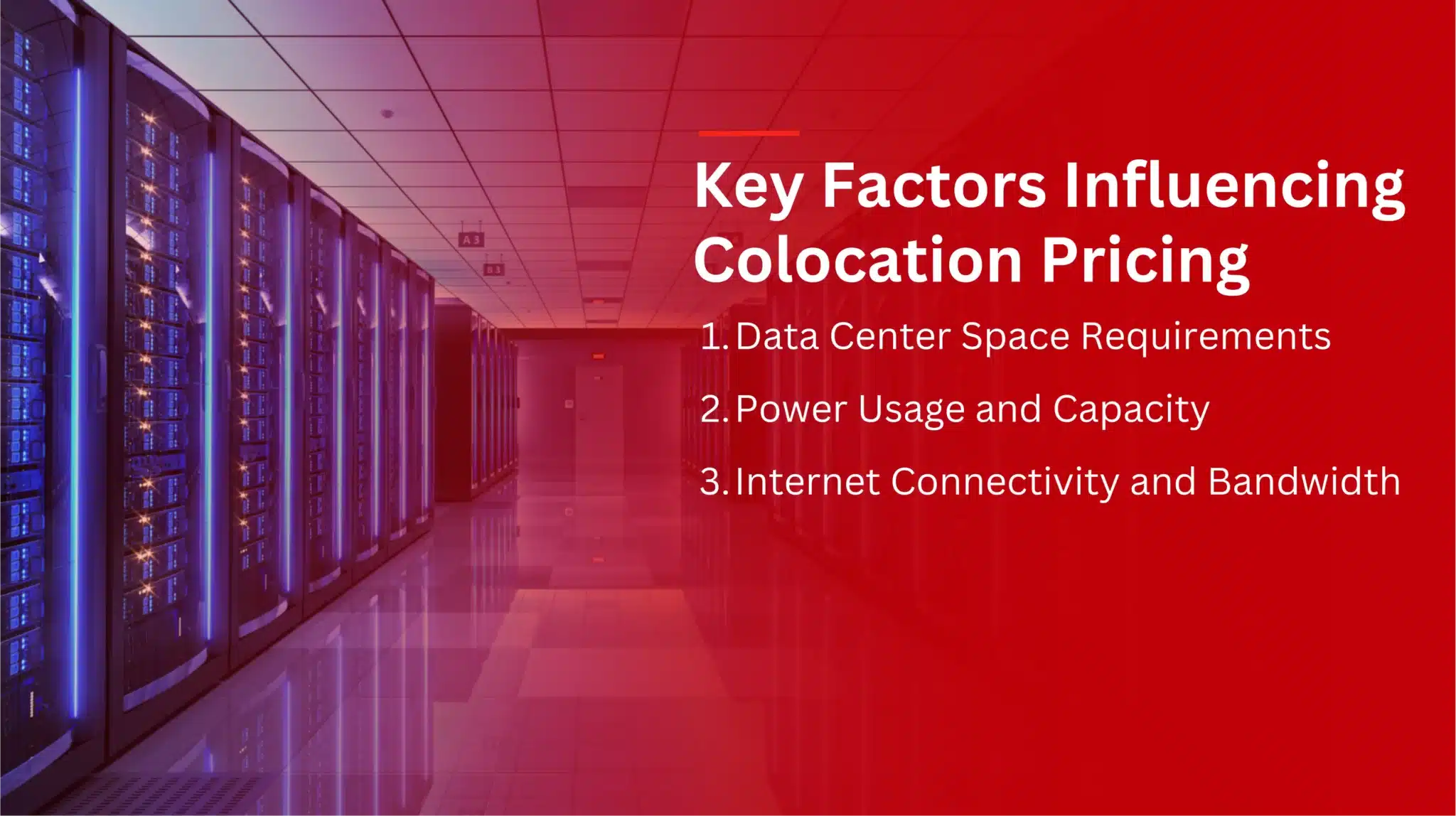Colocation pricing can vary widely based on your needs. In this guide, we break down the costs of space, power, and bandwidth so you can plan your budget accordingly.
In This Article:
- Key Factors Influencing Colocation Pricing
- Additional Costs in Colocation Services
- Real-World Examples of Colocation Pricing
- Evaluating Colocation Providers
- Hidden Fees to Watch For
Key Takeaways
- Colocation pricing is primarily affected by data center space, power usage, and internet connectivity, which businesses must carefully assess for accurate budgeting.
- Additional costs such as remote hands support, cross connections, and advanced security features can significantly impact total colocation expenses and should be factored in during evaluation.
- When selecting a colocation provider, it’s essential to consider factors like geographic location, service quality, and hidden fees to ensure optimal cost management and service reliability.
Key Factors Influencing Colocation Pricing
The cost of colocation is determined by several critical components that significantly shape the total expenses. These elements encompass the requirements for data center space, capacity and consumption of power, along with internet connectivity and bandwidth demands. Understanding these factors is essential for companies to allocate their colocation budget appropriately and make choices grounded in knowledge.
Requirements for data center space are described as the amount of physical space necessary to accommodate your hardware, typically quantified in terms of rack units. The usage and capacity related to power hold substantial importance because they have a direct influence on monthly charges, particularly for enterprises that necessitate high levels of redundancy.
Costs associated with internet connectivity and bandwidth utilization also play an integral role in dictating colocation pricing since escalated usage tends toward higher expense implications.
Data Center Space Requirements
The quantity of space you require in a data center is a crucial determinant of the cost associated with colocation. Charges from colocation providers are typically based on the amount of rented colocation space, encompassing options such as full racks, half racks, or individual units within a rack. For example, securing a full rack consumes about 30 square feet of physical floor area within the data center and thus influences the total expense for colocation.
For small enterprises seeking an economical solution that meets modest requirements for power and connectivity, half racks present an attractive option. This arrangement often involves monthly fees covering both rental space and electricity usage – offering these businesses an accessible financial entry point given their constrained necessities or budget limitations.
Conversely, larger organizations might opt for full racks to gain additional expansion capacity alongside dedicated secure areas for housing their equipment, considerations which may warrant higher investment due to enhanced spatial demands.
Power Usage and Capacity
The power needs of a business significantly impact the expenses associated with colocation, as higher energy use translates to elevated monthly charges. This is particularly pertinent for companies that need extensive redundancy to guarantee consistent uptime. Power consumption at colocation centers is usually calculated in kilowatts (kW), and it’s common for these facilities to see an average power draw between 60-65%.
Colocation costs can be billed either via a flat rate or through metered usage based on actual consumption, which affects the ability to forecast and budget these expenses accurately. When choosing a configuration for power supply, businesses must take into account both current energy needs and potential future increases to avoid unforeseen additional costs.
Typically, a rack housed within a colocation facility will require between 2-3 kW of power capacity. This consideration is essential when planning for overall energy capabilities.
Internet Connectivity and Bandwidth
The cost of colocation is largely influenced by the average bandwidth usage, with higher consumption leading to increased expenses. This is particularly true for enterprises in need of high-performance connectivity that offers low latency. Dedicated internet access and IP transit are often preferred for their quality of connectivity within colocation environments, though they come at a premium compared to shared options.
Various pricing structures exist for billing bandwidth use, including flat rate, metered usage, 95th percentile billing, and burstable billing strategies. When determining the price of colocation services, considerations such as monthly network data transfer amounts and the quantity of public IP addresses required play a crucial role in shaping total costs.
Additional Costs in Colocation Services
To the main considerations, a variety of extra expenses may impact the cost of colocation services. This encompasses fees for remote hands and technical assistance, as well as charges for cross connections and direct links. The need for enhanced security protocols and compliance with regulations should also be factored into the financial planning process when evaluating colocation services.
The expense is often greater when there is an increased level of redundancy in systems such as those designed for disaster recovery because they require additional power supplies, network infrastructure, and cooling capabilities. Initial expenditures associated with acquiring colocation services can differ significantly between providers. Some opt to eliminate setup fees as a strategy to draw in new clients.
Remote Hands and Technical Support
Technician support for server issues, provided through remote hands services, enables system administrators who are at a distance to oversee, manage power settings, and restart servers as needed. These services typically incur charges that vary from $75 to $500 per hour based on the complexity of the tasks undertaken. Such costs can substantially add to overall colocation expenses for companies needing regular technical assistance.
The expense associated with monitoring services is influenced by both the degree of surveillance necessary and how intricate the IT setup is. Should any problems arise while observing servers, technicians will be tasked with troubleshooting them—this additional intervention contributes to the problem. To cumulative costs.
Cross Connections and Direct Connections
Cabled links known as cross connections offer dedicated connectivity between two systems within a data center. These interconnection services incur charges per port, leading to monthly fees. The cost for these services differs geographically, with regions such as Australia and Europe typically incurring lower expenses compared to South America where the costs are higher.
Incorporating direct connections to cloud providers into colocation services can increase the total expense incurred by businesses. Such connections are vital for entities that depend on high-performance connectivity and minimal latency. They also bring extra costs that must be taken into account when evaluating overall pricing.
Security Measures and Compliance
Colocation facilities are equipped with sophisticated security features such as round-the-clock surveillance and biometric access systems to safeguard data integrity and security. Nevertheless, these enhanced security capabilities can significantly elevate colocation costs. Such increased expenses may be indicative of the necessity to adhere to regulatory compliance standards, which is an essential factor for companies operating in industries such as healthcare, finance, and government where strict data protection is required.
Real-World Examples of Colocation Pricing
Let’s delve into the realm of server colocation pricing by examining practical cases. By analyzing a range of situations from small businesses to large enterprises, as well as those necessitating disaster recovery solutions, we can gain deeper insight into how varying service demands and setups affect the overall expenses.
The cost associated with colocation fluctuates significantly based on individual business needs. Charges for services such as backup and recovery, establishing direct connections to cloud providers, along with extra fees for offerings like remote hands assistance and advanced security options are all integral components that shape the cumulative pricing for server colocation services.
Example 1: Small Business Setup
A common configuration for a small enterprise utilizing colocation services encompasses utilization of a half rack, suitable for fulfilling their moderate needs. This arrangement often comprises several pieces of server hardware and typically demands a modest power supply ranging from 1.5kW to 2kW per half rack. The internet connectivity requirements for such a business are usually average, with necessary bandwidth falling between 1-5 Mbps based on operational demand.
Employing remote hands services, establishing cross connections, and implementing enhanced security protocols can lead to an increase in the overall expenses associated with the colocation setup. It’s crucial that these additional costs be thoroughly assessed to guarantee that the selected colocation solution is in harmony with both the financial scope and strategic aims of the business.
Example 2: Enterprise Deployment
In the context of enterprise-level deployments, colocation demands often encompass several full racks, with the total cost being substantially influenced by how many racks are employed. It is important to address power usage when seeking high-performance connectivity—this entails planning for both necessary capacity and possible excess use scenarios.
The selection of appropriate internet connectivity is imperative as it can greatly escalate colocation expenses depending on bandwidth necessities. Expenditures may arise from services like remote hands support, cross connections, and superior security measures that are essential for upholding an enterprise-grade deployment.
Example 3: Disaster Recovery Configuration
Utilizing Disaster Recovery as a Service (DRaaS) vendors is frequently employed for implementing disaster recovery strategies within colocation environments. It’s essential to establish a disaster recovery plan due to the fact that data centers may suffer from disruptions caused by both natural disasters and human-induced incidents.
There exists a range of complexity in disaster recovery services, which correspondingly affects their cost. This underscores the necessity of carefully assessing available choices in relation to one’s financial constraints and specific requirements.
Evaluating Colocation Providers
It’s essential to carefully assess colocation providers to guarantee you are making a cost-effective decision. When considering such providers, one must take into account various elements like the amount of space available, power usage, bandwidth capabilities, and where they’re geographically located. Knowledge of bandwidth options is particularly important as it helps companies make educated choices about which colocation provider to choose and how to minimize costs.
A thorough analysis should also involve examining customer support services, the range of products offered by the provider, and their ability to integrate hybrid cloud architectures effectively. For businesses operating in sensitive sectors such as healthcare, finance or government roles where data protection is crucial—ensuring that security measures meet stringent standards for compliance holds significant importance when selecting a colocation service provider.
Assessing Data Center Quality and Reliability
Assessing the quality and dependability of a data center hinges significantly on uptime guarantees. Colocation services provide colocation services. Offer an uptime guarantee of approximately 99.95%, which plays a crucial role in maintaining uninterrupted operations. It’s important to investigate both the historical uptime performance and industry-specific compliance certifications when considering different providers.
To enhance system redundancy and boost overall reliability, numerous companies utilize more than one data center as part of their disaster recovery strategies. The server infrastructure housed within colocation facilities is typically under scrutiny with checks conducted every minute to ensure consistent reliability, representing an essential factor in the evaluation process for colocation providers and the array of services they provide in terms of data centers.
Comparing Service Levels and Support Options
The degree of support provided can vary greatly between different colocation providers and service provider choices, influencing the promptness of their response as well as the extent of expertise available to customers.
By evaluating the various levels of service and support offerings, you can ensure that you obtain high-quality services that are in sync with your business requirements.
Geographic Location Considerations
The pricing and latency of colocation services are significantly influenced by the geographic location of data centers. In regions with high demand, such as New England or California, colocation prices are often elevated owing to the dynamics between supply and demand. The presence of numerous providers in a particular area can lead to competitive pricing due to increased competition.
For successful planning and managing expenses related to colocation services, it’s essential for businesses to thoroughly assess the geographical positioning of potential data centers. This is vital in fulfilling their specific needs regarding latency and connectivity requirements.
Hidden Fees to Watch For
Hidden fees can significantly impact overall colocation costs. Local taxes, parking fees, and travel costs for the team can compound total colocation pricing, making it essential to scrutinize contracts for any additional expenses. Longer contract lengths may lower monthly costs but come with risks related to providers’ stability and technology advancements.
Colocation contracts may have hidden fees that can significantly affect total expenses. Awareness of these potential charges helps businesses avoid unexpected costs and manage their colocation budgets better.
Power Overages and Burstable Billing
When users exceed the consumption thresholds specified in their contracts, they may be subject to extra charges for power overages. If peak usage is not closely monitored under burstable billing models that charge based on maximum usage spikes, it can result in unforeseen expenses.
Bandwidth Overage Charges
When the data transfer goes beyond what is stipulated in the colocation contract, extra costs are incurred due to bandwidth overage charges. This happens if you exceed your contracted allotment for data transmission, leading to financial implications.
Setup Fees and Initial Costs
Setup fees and initial costs can vary significantly among colocation providers. Security, redundant power, backups, engineer consulting, and load balancing can impact startup fees in colocation pricing. Some providers opt to waive setup fees entirely to attract more customers.
Installation fees are often negotiable based on terms set by colocation providers. Prioritizing the recurring monthly rate over setup fees is crucial when evaluating colocation agreements. For instance, Sectorlink does not charge any setup fees for their colocation services.
 Summary
Summary
Assessing the cost of colocation requires a detailed examination of several aspects, such as the amount of data center space needed, consumption of power, and options for internet connectivity. Additional expenditures like services for remote hands assistance, fees for cross connections, and upgraded security protocols must also be taken into account. Awareness of potential hidden charges is crucial when reviewing different colocation providers in order to make well-informed choices that align with budgetary constraints.
Businesses should meticulously analyze these factors along with practical examples to uncover economical yet effective colocation solutions tailored to their specific requirements. The ultimate aim is finding an equilibrium between expenses and value delivered. This ensures your business operations are supported by a dependable and secure infrastructure facilitated through selected colocation services.
Frequently Asked Questions
How much does colocation cost in Boston?
Colocation in Boston can start as low as $75 per month, with no minimum server package required at some providers. This pricing makes it accessible for various businesses looking for reliable hosting solutions.
What is colocation pricing?
Colocation pricing pertains to the expenses involved in renting space for data center equipment, encompassing costs for physical space, power, cooling, and security.
This model enables businesses to maintain their own servers while benefiting from a secure and managed environment.
What factors most significantly impact colocation pricing?
Pricing for colocation is majorly affected by elements including the amount of space within a data center, consumption of power, and internet bandwidth. Prices may be augmented due to extra services such as advanced security provisions and remote hands.
Grasping these components is essential for making well-informed choices pertaining to colocation services.
How does power usage affect colocation costs?
Power usage significantly influences colocation costs, as higher consumption results in increased monthly fees. It is essential to understand whether your billing model is flat rate or metered, as this will impact budgeting and predictability.
What are cross connections, and how do they impact colocation pricing?
Cross connections are cabled links between systems in a data center that offer dedicated connectivity, and they typically incur charges on a per-port basis, influencing colocation pricing through added monthly costs that may vary by region.


